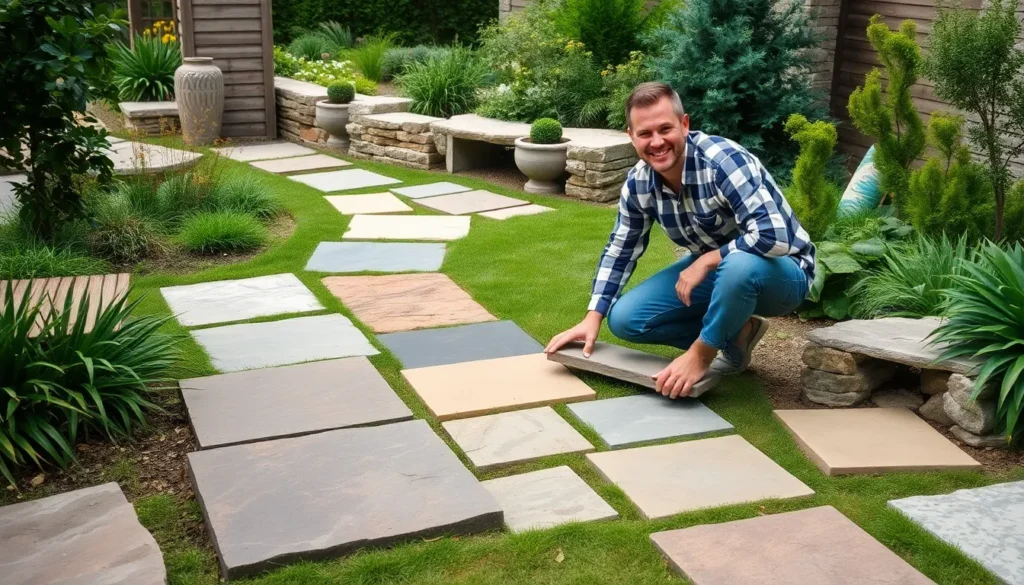Transforming your outdoor space into a stunning retreat doesn’t have to expensive or require extensive construction work. Garden slabs offer one of the most versatile and cost-effective ways to create beautiful patios walkways and garden features that’ll enhance your home’s curb appeal for years to come.
We’ve discovered that the right slab choices can completely revolutionize how you use and enjoy your garden space. From sleek modern concrete designs to rustic natural stone options there’s a perfect slab solution for every style preference and budget. Whether you’re planning a cozy seating area a dramatic pathway or an entire patio makeover the possibilities are truly endless.
The best part? Most garden slab projects are surprisingly DIY-friendly allowing us to achieve professional-looking results without the hefty contractor fees. Let’s explore the most inspiring and practical garden slab ideas that’ll turn your outdoor dreams into reality.
Natural Stone Slabs for Timeless Garden Elegance
Natural stone slabs bring unmatched beauty and lasting value to outdoor spaces. We’ll explore three popular natural stone options that create stunning garden features while maintaining their appeal for decades.
Limestone Slabs for Classic Appeal
Limestone slabs offer neutral tones ranging from creamy whites to warm grays that complement any garden style. We love how this sedimentary stone weathers gracefully over time, developing a natural patina that enhances its character. Popular limestone varieties include Cotswold stone for traditional English garden aesthetics and Indiana limestone for clean contemporary designs.
These slabs work exceptionally well for formal garden paths, terrace areas, and poolside installations. We recommend choosing honed or tumbled finishes for better slip resistance in wet conditions. Limestone’s porous nature allows for excellent drainage while maintaining structural integrity in freeze-thaw cycles.
Installation costs typically range from $15-25 per square foot including materials and labor. We suggest sealing limestone slabs every 2-3 years to protect against staining and weather damage.
Granite Slabs for Durability and Sophistication
Granite slabs deliver unparalleled strength and resistance to weathering, making them ideal for high-traffic garden areas. We appreciate granite’s diverse color palette, from classic gray and black to dramatic blues and reds that create striking focal points. Popular varieties include Absolute Black for modern minimalist designs and Silver Pearl for elegant traditional settings.
These dense igneous stone slabs resist scratching, chipping, and staining better than other natural options. We often recommend granite for outdoor kitchen countertops, fire pit surrounds, and main walkway installations where durability matters most. The polished surface reflects light beautifully while textured finishes provide better traction.
Granite slab installation costs range from $20-40 per square foot depending on thickness and finish quality. We find that granite’s longevity makes it a cost-effective choice even though higher upfront investment.
Sandstone Slabs for Rustic Charm
Sandstone slabs bring warm, earthy tones that blend naturally with industry plantings and create inviting outdoor spaces. We love the textural variety available, from smooth river-washed surfaces to rough-hewn quarry finishes that add visual interest. Popular colors include buff, red, and brown tones that complement both cottage and contemporary garden designs.
These sedimentary stone slabs offer natural slip resistance through their slightly rough surface texture. We recommend sandstone for garden steps, patio areas, and informal pathway applications where a relaxed atmosphere is desired. The stone’s natural porosity allows rainwater to drain effectively while preventing puddle formation.
Sandstone installation typically costs $12-20 per square foot including professional laying. We suggest applying a breathable sealer every 3-4 years to maintain color vibrancy while allowing moisture vapor transmission.
Concrete Garden Slabs for Modern Outdoor Spaces
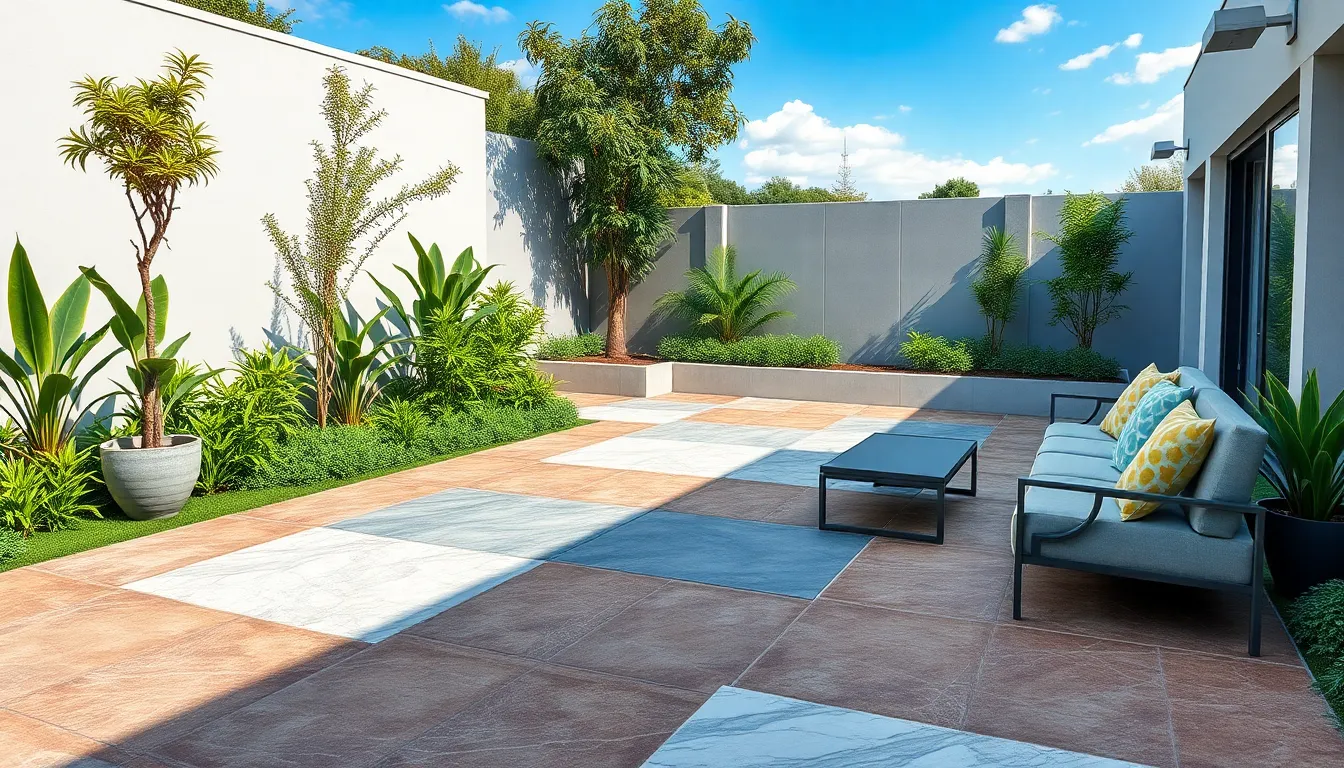
While natural stone offers timeless beauty, concrete garden slabs provide unmatched versatility and affordability for contemporary outdoor designs. We’ve found concrete slabs are particularly appealing for homeowners seeking customizable options that complement modern landscaping aesthetics.
Stamped Concrete Patterns and Textures
Stamped concrete transforms ordinary slabs into sophisticated surfaces that mimic premium materials like stone, brick, or wood. Patterns range from simple geometric designs to complex natural textures, offering a textured look that adds visual interest to your garden pathways and patios. Installation creates surfaces that closely resemble expensive materials at a fraction of the cost.
Design options include cobblestone patterns for European elegance, wood grain textures for rustic appeal, and slate impressions for contemporary styling. We recommend stamped concrete for homeowners seeking a unique, less maintenance intensive option compared to natural materials. Professional installation typically costs $8-12 per square foot, making it significantly more affordable than authentic stone alternatives.
Colored Concrete Options for Visual Interest
Colored concrete creates harmonious palettes that complement your garden’s existing surroundings and architectural features. Pigments can be added to the concrete mix to achieve a wide range of colors, from subtle pastels like sage green and cream to vibrant hues such as terracotta and deep blue. Integral coloring ensures consistent color throughout the slab, preventing chipping and fading issues common with surface treatments.
Popular color combinations include warm earth tones that blend with natural landscaping and cool grays that enhance modern outdoor furniture. We’ve observed that colored concrete allows for creative expression and can enhance the aesthetic appeal of outdoor spaces by creating focal points or defining different garden zones. Acid staining provides another coloring option, creating variegated effects that mimic natural stone variations.
Aggregate Concrete for Added Texture
Aggregate concrete incorporates small rocks, pebbles, or recycled glass into the mix, providing a textured finish that’s both functional and decorative. Exposed aggregate techniques reveal these materials on the surface, creating naturally slip resistant walkways and patios. Common aggregate materials include river rock, crushed granite, and decorative glass beads in various sizes and colors.
Surface preparation involves washing away the top layer of cement paste to expose the aggregate beneath, resulting in a durable, textured finish. We find this technique particularly effective when combined with other design elements like contrasting colors or geometric patterns. Aggregate concrete costs approximately $10-15 per square foot installed and requires minimal maintenance while providing excellent traction in wet conditions.
Porcelain Slabs for Low-Maintenance Garden Areas

We consider porcelain slabs the ultimate solution when durability meets minimal upkeep requirements. These innovative garden surfaces offer superior performance compared to traditional materials while maintaining aesthetic appeal.
Weather-Resistant Properties and Benefits
Durability stands as porcelain slabs’ greatest advantage, with exceptional resistance to scratches, stains, and fading that makes them perfect for high-traffic garden areas. Heavy foot traffic and harsh weather conditions won’t compromise their integrity over time. Water resistance becomes another crucial benefit since these slabs remain completely impervious to water, oil, and chemical spills. Staining concerns that plague concrete or wood surfaces simply don’t exist with porcelain materials.
Maintenance requirements drop significantly compared to natural alternatives since annual re-sealing isn’t necessary. This convenience factor makes porcelain slabs ideal for busy homeowners who want beautiful garden paths and patios without constant upkeep. Weather exposure won’t degrade the surface quality, ensuring your investment maintains its appearance year after year.
Contemporary Design Options Available
Versatility defines porcelain slab design possibilities, offering an extensive range of colors, sizes, and finishes for creating unique outdoor spaces. Custom configurations become achievable when you have multiple style options at your disposal. Surface textures can perfectly mimic natural stone or wood appearances, providing premium aesthetics without the associated maintenance costs.
Style choices expand beyond traditional limitations since manufacturers now produce porcelain slabs in countless variations. Modern geometric patterns, rustic wood grain effects, and classic stone textures all become available options. Color palettes range from neutral earth tones to bold contemporary shades, allowing you to match any design vision.
Easy Installation and Cleaning Methods
Installation processes mirror standard paver techniques, making porcelain slabs accessible for both professional contractors and DIY enthusiasts. Sand or concrete base preparation follows conventional methods, while the slabs themselves lay similarly to other paving materials. Setup complexity remains minimal compared to natural stone alternatives.
Cleaning requirements stay remarkably simple with basic brushing or hot soapy water handling most maintenance needs. Stubborn dirt responds well to pressure washing without causing surface damage, unlike more delicate materials. Regular maintenance involves nothing more than occasional cleaning, making these slabs perfect for low-maintenance garden areas.
Reclaimed and Recycled Slab Ideas for Eco-Friendly Gardens
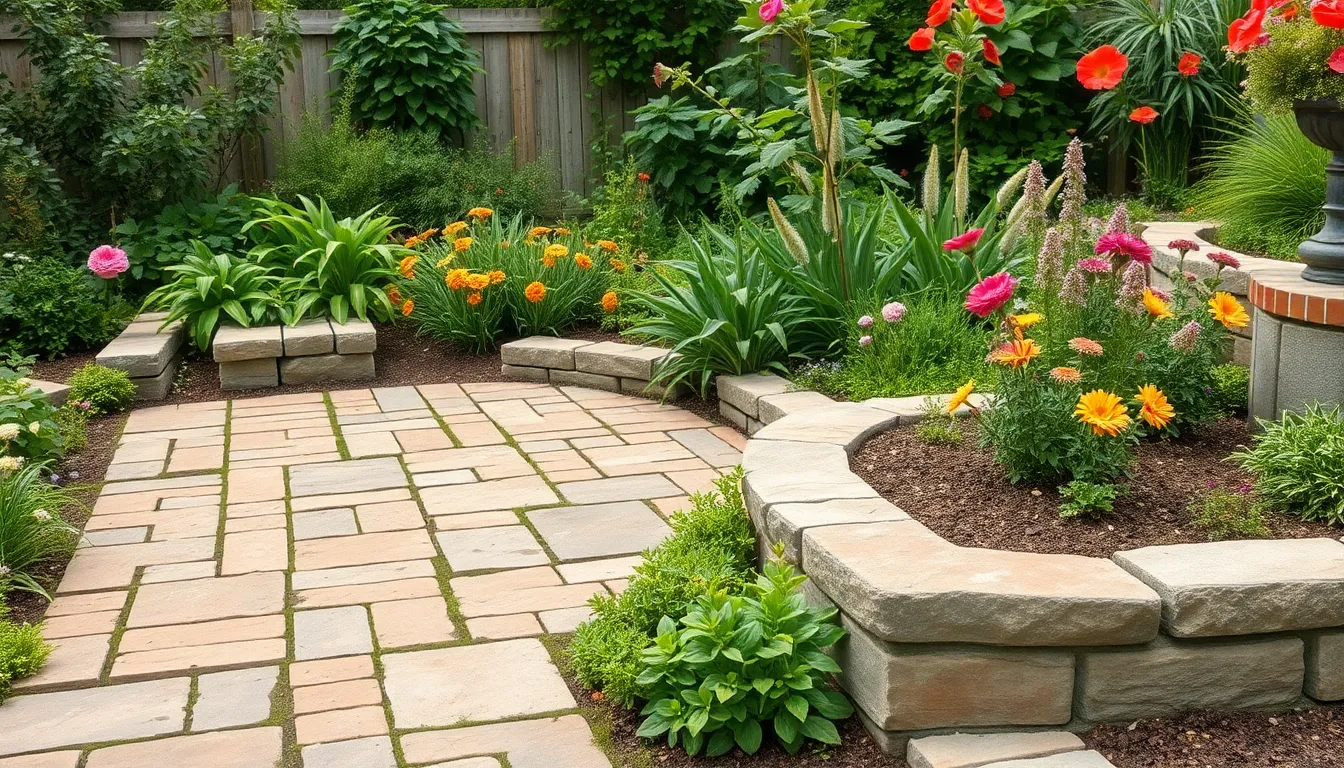
Building on sustainable outdoor design principles, we’re exploring how reclaimed and recycled materials can transform your garden while protecting our environment. These eco-conscious slab options deliver both aesthetic appeal and environmental responsibility.
Repurposed Building Materials as Garden Slabs
Reclaimed brick from old buildings brings historical character to modern gardens while diverting waste from landfills. We can install these weathered bricks as pathway surfaces, retaining walls, or decorative garden borders that tell a story of architectural heritage. The natural patina and varied colors create an authentic vintage appeal that’s impossible to replicate with new materials.
Recycled concrete slabs known as urbanite offer incredible versatility for eco-friendly landscaping projects. Construction sites generate tons of concrete waste that we can repurpose into durable pathways, sturdy retaining walls, and attractive patio surfaces. These slabs cost significantly less than new concrete while providing the same structural integrity and longevity.
Reclaimed wood transforms old building materials into stunning garden decking and decorative borders that complement natural settings. Salvaged timber from demolished structures, old barns, or shipping pallets creates unique textures and rich wood tones. We can treat these materials to resist weather damage while maintaining their rustic charm and environmental benefits.
Salvaged Stone and Brick Options
Reclaimed stone from demolished structures provides natural beauty with a weathered patina that new stone simply can’t match. These salvaged materials work perfectly for creating elegant patios, meandering walkways, and garden focal points. The aged appearance adds instant character while reducing quarrying demands on natural resources.
Recycled rubber slabs made from 100% recycled tire materials offer exceptional durability and weather resistance for high-traffic garden areas. These innovative slabs require minimal maintenance, resist cracking in extreme temperatures, and provide excellent slip resistance for wet conditions. We can choose from various colors and textures to match any garden design theme.
Salvaged brick delivers classic aesthetic appeal while supporting sustainable landscaping practices through material reuse. Construction demolition projects generate thousands of usable bricks that we can incorporate into driveways, garden walls, and decorative features. The natural color variations and weathered surfaces create authentic charm that enhances traditional and contemporary gardens alike.
Environmental Benefits of Recycled Materials
Waste reduction represents the primary advantage of choosing reclaimed materials for garden slab projects. Construction and demolition waste accounts for approximately 40% of total solid waste generation, making material reuse essential for environmental protection. We significantly reduce landfill burden by selecting recycled concrete, salvaged stone, and reclaimed brick for our outdoor spaces.
Resource conservation occurs naturally when we choose recycled materials over newly manufactured alternatives. Stone quarrying, concrete production, and brick manufacturing consume enormous amounts of energy and raw materials while generating substantial carbon emissions. Selecting reclaimed options reduces demand for these resource-intensive processes while maintaining the same functional benefits.
Sustainable landscaping practices become achievable when we incorporate recycled materials into our garden design strategies. These eco-friendly choices support circular economy principles by extending material lifespans and reducing environmental impact. We create beautiful outdoor spaces while demonstrating environmental stewardship that inspires others to make similar sustainable choices.
Creative Slab Layout Patterns and Designs
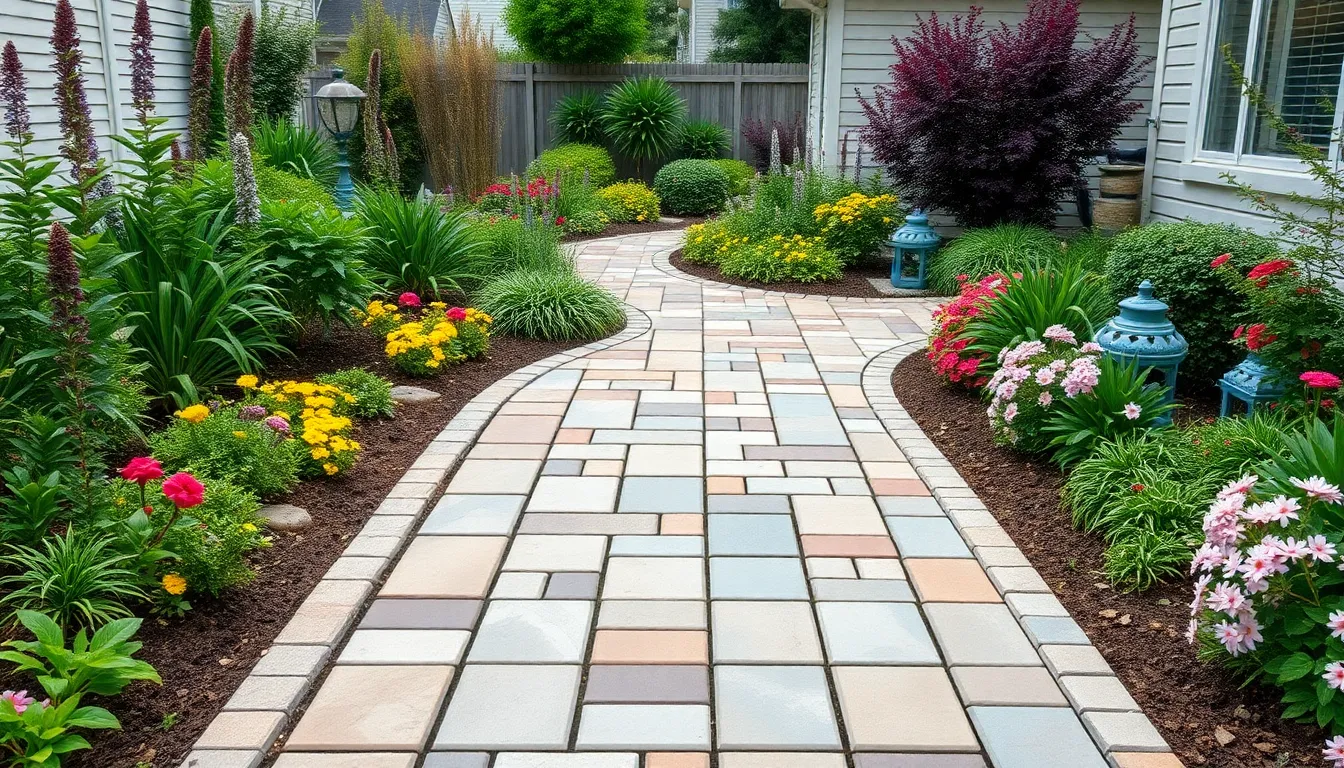
Now that we’ve explored various slab materials and their eco-friendly alternatives, let’s jump into the artistic side of garden design. The way we arrange our slabs can dramatically transform the entire look and feel of our outdoor spaces.
Herringbone Patterns for Visual Movement
Herringbone patterns create ever-changing visual interest by laying slabs in alternating directions that form distinctive V-shaped or zigzag formations. This classic design technique generates a sense of movement across your garden surface, making it particularly effective for driveways and walkways where you want to guide the eye naturally along the path.
We can achieve stunning results with herringbone layouts because they work exceptionally well with rectangular slabs of uniform size. The alternating directional placement creates depth and texture that makes even simple concrete slabs appear more sophisticated and intentional.
Installation becomes straightforward when we start from a straight edge and work outward, ensuring each row maintains the alternating pattern. Professional landscapers often recommend herringbone designs for high-traffic areas since the interlocking pattern provides excellent structural stability.
Random Layout Designs for Natural Appeal
Random patterns offer the perfect solution when we want our garden spaces to feel organic and naturally occurring rather than overly structured. This design approach involves laying slabs in non-uniform, irregular arrangements that mimic the way natural stone formations appear in nature.
We can create authentic-looking random layouts by varying both the size and orientation of our slabs, avoiding any repetitive patterns that might make the design feel forced. Mixed-size installations work particularly well with natural stone materials like limestone and sandstone, where slight variations in shape and color enhance the organic appearance.
Planning becomes crucial with random designs since we need to ensure proper spacing and structural integrity while maintaining the natural, unplanned aesthetic. Many homeowners find success by laying out their pattern on the ground first before committing to the final installation.
Grid Patterns for Structured Garden Spaces
Grid patterns deliver clean, contemporary aesthetics through their structured and geometric approach to slab placement. Stack bond arrangements create the most straightforward grid design by laying pavers in straight, aligned rows that form a modern, minimalist appearance perfect for contemporary garden styles.
We can enhance basic grid layouts by incorporating slabs of varying sizes while maintaining the overall structured framework. This technique combines different slab dimensions to create visual dynamics within the organized grid system, preventing the design from appearing too rigid or monotonous.
Modern installations often feature grid patterns because they complement architectural elements and create seamless transitions between indoor and outdoor living spaces. The systematic arrangement works exceptionally well with porcelain slabs and colored concrete options where uniform sizing and consistent coloring emphasize the geometric precision.
Mixed Material Garden Slab Combinations
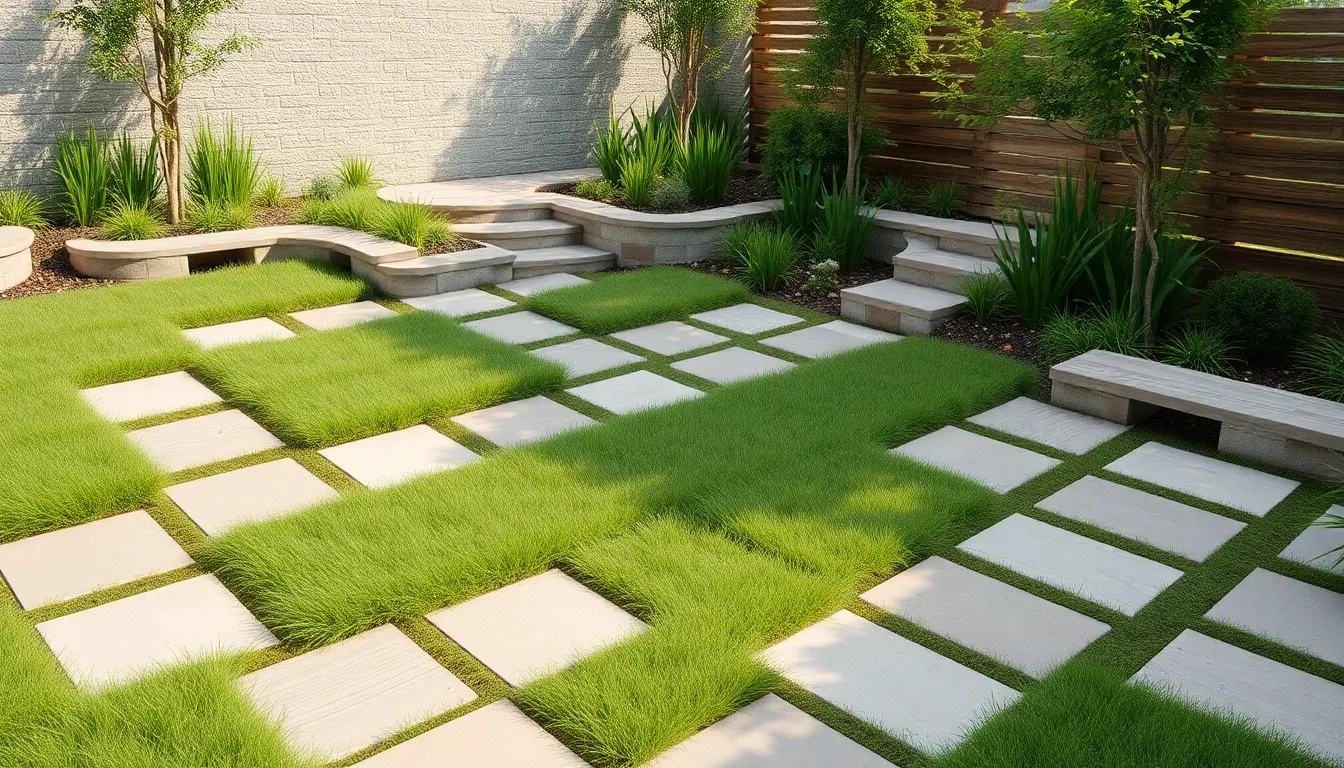
Building on creative layout patterns, we can elevate our garden design by combining different materials to create stunning visual contrasts and improved functionality. Mixed material approaches offer enhanced permeability, unique textures, and customization options that suit both traditional and modern architectural styles.
Stone and Gravel Integration Ideas
Natural stone slabs paired with loose gravel create a rustic, permeable surface that’s both beautiful and practical. Flagstone combined with pea gravel offers excellent drainage while maintaining an elegant appearance for garden pathways. Slate slabs integrated with crushed granite provide a sophisticated texture that works perfectly for patio seating areas.
The stone elements deliver durability and visual structure to your outdoor space. Gravel fills the gaps between slabs, allowing water to drain naturally while creating a soft, organic look. This combination proves especially effective for high traffic areas where both aesthetics and functionality matter.
We recommend using this approach for garden walkways, entertainment patios, or quiet seating nooks. The permeable nature supports sustainable landscaping practices by reducing runoff and promoting groundwater recharge.
Slab and Grass Checkerboard Patterns
Alternating garden slabs with grass squares creates a ever-changing, textured effect that transforms ordinary outdoor spaces. Concrete slabs combined with grass patches offer a modern aesthetic while improving permeability throughout your garden. Stone pavers alternating with turf provide a more traditional look that complements classic garden designs.
This pattern supports plant growth between hardscaped areas, creating natural cooling zones in your outdoor space. The grass sections reduce overall material costs while adding environmental benefits to your industry design. Installation requires careful planning to ensure proper drainage and grass health in the planted squares.
Checkerboard layouts work exceptionally well for residential gardens where you want both function and visual appeal. The pattern makes pathways feel less rigid while maintaining clear traffic flow through your outdoor areas.
Wood and Stone Combination Designs
Wooden elements paired with stone or concrete slabs bring warmth and natural texture to outdoor entertainment areas. Wooden sleepers combined with stone slabs create defined spaces while providing striking material contrast. Deck boards integrated with concrete pavers offer a balance between natural and engineered materials that suits contemporary settings.
This design approach works beautifully for patio edges, seating areas, and transition zones between different garden spaces. The wood adds warmth and comfort, while stone provides durability and structure to high use areas. The combination adapts well to both rustic and modern outdoor design themes.
We find this particularly effective for decking projects where you want to break up large expanses of single materials. The mixed approach creates visual interest while serving practical functions like defining dining areas or creating built in seating answers.
Budget-Friendly Garden Slab Alternatives
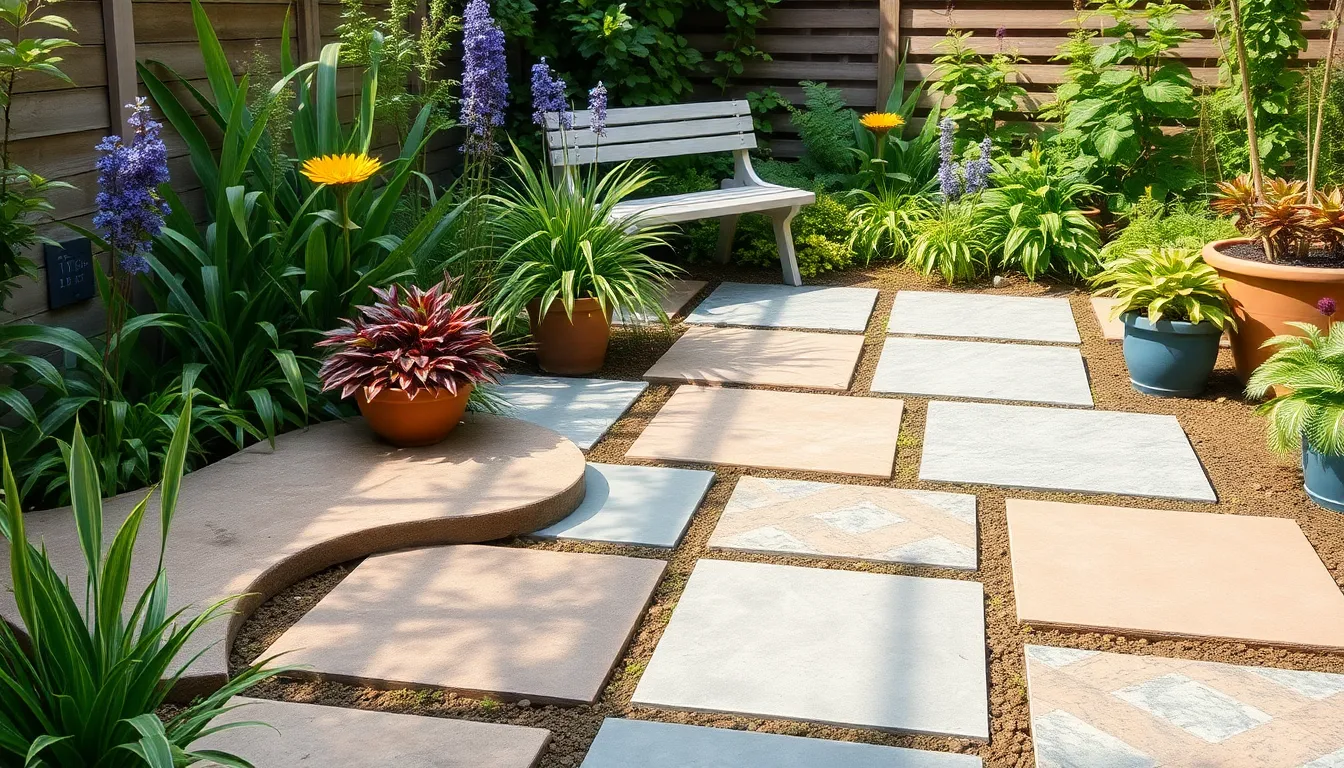
Creating stunning outdoor spaces doesn’t require very costly when you explore smart alternatives to expensive natural stone. We’ll show you practical answers that deliver professional results while keeping costs manageable.
DIY Concrete Slab Answers
Basic concrete offers unbeatable value at just $4 to $8 per square foot for materials, making it our top recommendation for budget-conscious homeowners. Labor costs add another $2 to $4 per square foot, but we can eliminate these expenses by tackling the project ourselves.
Excavation marks the first step in our concrete slab installation process. We mark the desired area and dig down approximately 4 inches to create a stable foundation for our slabs.
Formwork construction comes next as we build wooden frames to contain the concrete during pouring. These temporary structures ensure clean edges and proper slab thickness throughout our project.
Pouring concrete requires careful attention to achieve level surfaces across the entire area. We pour the mixture into our prepared formwork and use screeding tools to create uniform thickness.
Finishing techniques determine the final appearance of our concrete slabs. We smooth the surface using floats and trowels, then allow the concrete to cure for at least 24 hours before removing the formwork.
Affordable Composite Materials
Recycled plastic composites provide excellent durability while supporting environmental sustainability in our garden projects. These materials resist moisture, insects, and weathering better than traditional wood alternatives.
Wood composite options combine natural fibers with recycled plastics to create attractive surfaces for decking and similar applications. We find these materials particularly useful for creating raised platforms and transitional areas between different slab sections.
Installation simplicity makes composite materials appealing for DIY enthusiasts who want professional looking results. Most composite products feature interlocking systems that reduce installation time and complexity.
Maintenance requirements stay minimal with composite materials, as they don’t require annual sealing or staining like natural wood products. This long term cost savings makes them increasingly attractive for our budget conscious projects.
Cost-Effective Installation Tips
Reusing materials dramatically reduces project costs while adding unique character to our garden spaces. Old bricks from construction sites and builders’ merchants create classic, rustic charm at fraction of new material prices.
Railway sleepers offer versatile design possibilities and compelling stories for our industry projects. We source these materials from timber yards or online marketplaces to add distinctive elements to our gardens.
Gravel installations provide the most economical option at approximately $2.00 per square foot with easy installation requirements. This semi-permeable material works perfectly for informal pathways and low traffic areas.
Permeable pavers combine eco-friendly benefits with reasonable costs by allowing water drainage while reducing runoff maintenance. We recommend these options for environmentally conscious homeowners seeking sustainable answers.
Design optimization minimizes material waste and reduces labor time through careful planning. We measure accurately and create detailed layouts before beginning installation to avoid costly mistakes and material overages.
Specialized Garden Slab Applications
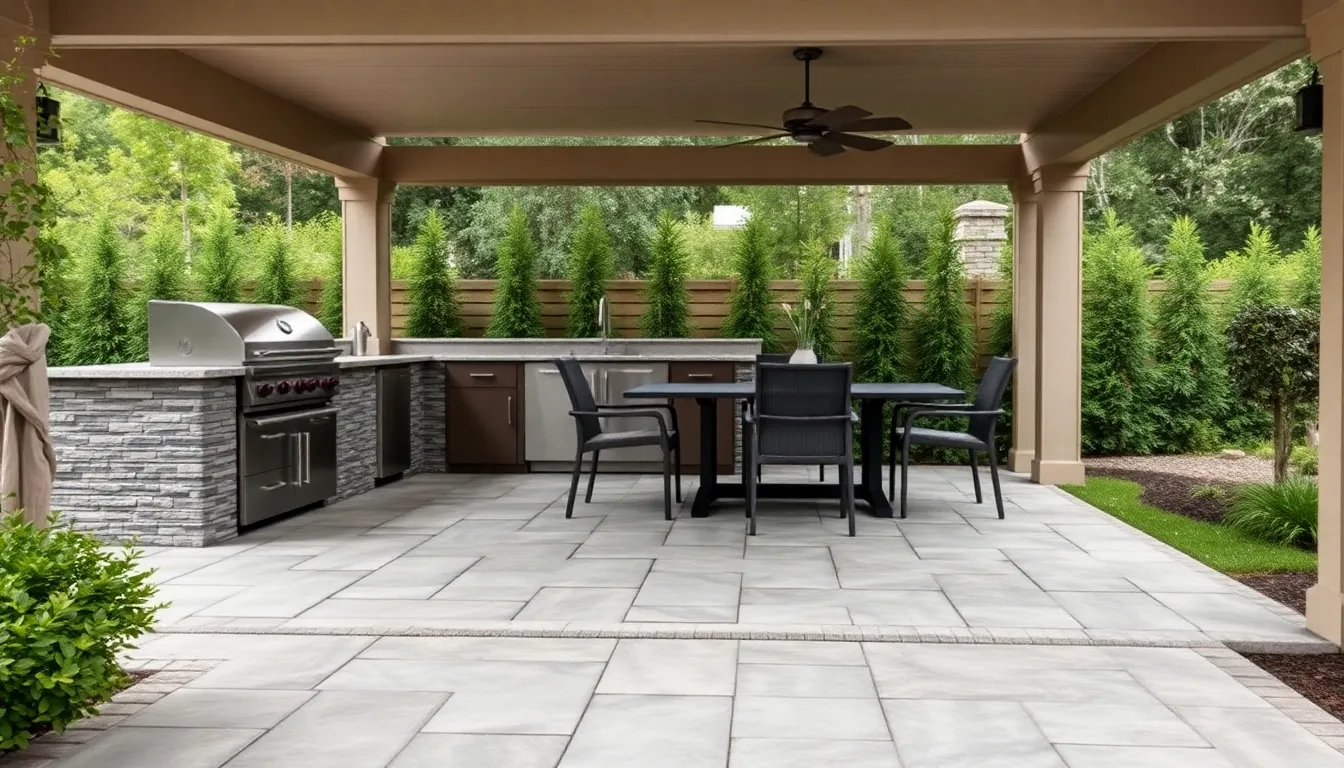
Certain areas of your outdoor space demand exact slab characteristics to ensure both functionality and safety. We’ll explore three key applications where choosing the right garden slabs makes all the difference.
Pool Area and Water Feature Surrounds
Slip-resistant surfaces become crucial when designing pool areas and water feature surrounds. We recommend limestone or concrete pavers with textured finishes that provide both safety and aesthetic appeal in these wet environments.
Safety considerations should drive your material selection, as smooth surfaces become dangerously slippery when wet. Textured concrete pavers offer excellent grip while maintaining a sophisticated appearance around swimming pools and fountains.
Durability requirements for pool areas mean selecting materials that can withstand constant moisture exposure and chemical treatments. Limestone slabs excel in these conditions, offering natural resistance to pool chemicals while maintaining their elegant appearance over time.
Outdoor Kitchen and Dining Spaces
Seamless transitions from indoor to outdoor living spaces create sophisticated entertainment areas using carefully selected garden slabs. We suggest manufactured concrete patios or traditional stonecast paving to define cooking and dining zones effectively.
Heat resistance becomes essential when placing slabs near grills and outdoor cooking equipment. Manufactured concrete pavers handle high temperatures without cracking or discoloration, making them ideal for outdoor kitchen installations.
Easy maintenance matters in dining areas where spills and food preparation occur regularly. Traditional stonecast paving provides a non-porous surface that cleans easily while adding visual sophistication to your outdoor entertaining space.
Garden Path and Walkway Answers
Random-sized paving slabs with antiqued finishes create charming pathways that enhance your garden’s natural beauty. We recommend using varied slab sizes to establish organic, meandering routes through your industry.
Timeless materials like Hênslate or Yorkstone paving offer classic style that complements any garden design. These materials develop character over time, creating paths that feel established and permanent in your outdoor space.
Pattern flexibility allows you to customize walkway designs using different slab arrangements and spacing. Antiqued finishes on random-sized slabs provide visual interest while maintaining the natural, weathered appearance that makes garden paths feel authentic.
Maintenance and Care Tips for Garden Slabs
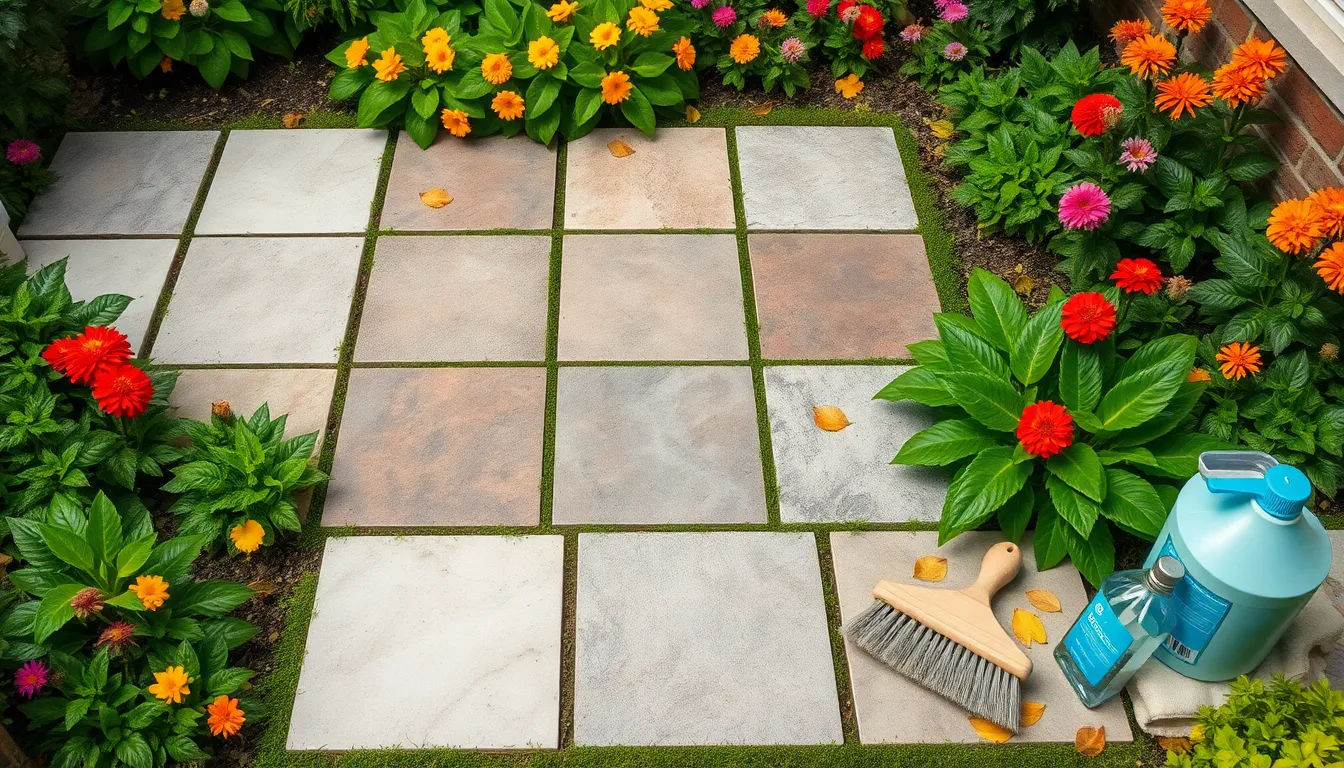
Proper maintenance extends the life of your garden slabs while preserving their appearance and functionality. We’ll explore essential care techniques that keep your investment looking pristine for years to come.
Cleaning Methods for Different Materials
Natural stone and concrete slabs require gentle yet effective cleaning approaches. We recommend using warm soapy water for routine maintenance, which removes most surface dirt and grime effectively. Tougher stains need gentle scrubbing with a soft brush to avoid surface damage. Pressure washing works well for deep cleaning, but we always maintain at least 12 inches of distance from the surface to prevent etching or chipping.
Pavers demand specialized attention for optimal results. Regular cleaning with mild detergent keeps them looking fresh throughout the season. Stubborn stains respond well to specialized cleaning products like Techniseal, which we’ve found particularly effective for removing oil and grease marks. Always test cleaning products on a small, inconspicuous area before applying them to the entire surface.
Different materials require customized cleaning frequencies and methods. Porcelain slabs need only basic brushing or light pressure washing due to their non-porous nature. Concrete options benefit from monthly cleaning to prevent buildup of organic matter. Natural stone varieties like limestone and sandstone require more frequent attention in shaded areas where moss and algae tend to develop.
Seasonal Maintenance Requirements
Spring and summer maintenance focuses on preventing damage before it occurs. We regularly sweep away debris and dust to prevent stains from setting into the surface. Moss and algae growth becomes more problematic in shaded areas during warm months, requiring immediate treatment to prevent permanent discoloration. Weekly inspections help us catch issues early when they’re easiest to address.
Autumn brings unique challenges that require exact attention. Fallen leaves must be brushed off frequently to prevent staining and fungal growth on the slab surface. We’ve learned that wet leaves can create persistent stains if left in place for extended periods. Regular removal also prevents slippery conditions that can create safety hazards.
Winter care protects slabs from freeze-thaw damage and snow accumulation. De-icing salts like sodium chloride or calcium chloride effectively remove snow and ice buildup. But, we avoid using these chemicals on certain paver types that can be damaged by salt exposure. Teflon blades on snow removal equipment prevent scratching during winter maintenance activities.
Long-Term Preservation Strategies
Sealing provides the most effective long-term protection for most slab materials. We apply patio sealant every three to five years to protect against weathering and maintain color vibrancy. This protective barrier reduces cleaning frequency and prevents deep staining from spills and organic matter. Regular sealing also helps prevent efflorescence, the white chalky residue that can appear on concrete surfaces.
Moss removal requires systematic treatment to prevent recurring problems. A mixture of water and chlorine bleach effectively removes moss from joints and surface areas. We apply the solution, allow it to work for several minutes, then scrub gently before rinsing thoroughly. This treatment works best when performed during dry weather conditions.
Joint maintenance prevents structural issues that can compromise slab stability. Regular inspection reveals moss and algae growth in damp areas where water tends to collect. We address these problems immediately to prevent root systems from widening joints and creating instability. Polymeric sand replacement every few years maintains proper joint integrity and prevents weed growth.
Conclusion
We’ve explored an incredible range of garden slab options that can transform any outdoor space into something truly special. From budget-friendly concrete answers to luxurious natural stone and low-maintenance porcelain there’s a perfect match for every style and budget.
The key to success lies in choosing materials that align with your exact needs whether that’s creating slip-resistant pool areas heat-resistant outdoor kitchens or charming garden pathways. Remember that proper installation and regular maintenance will ensure your investment continues to enhance your outdoor space for years to come.
With the right planning and these practical ideas you’re well-equipped to create the garden retreat you’ve always envisioned. Your outdoor transformation awaits!
Frequently Asked Questions
What are garden slabs and why are they popular for outdoor spaces?
Garden slabs are versatile paving materials used to create patios, walkways, and garden features. They’re popular because they offer a cost-effective way to transform outdoor spaces into beautiful retreats. Available in various materials from modern concrete to natural stone, they cater to different styles and budgets while being DIY-friendly for homeowners.
What are the main types of natural stone slabs available?
The three most popular natural stone options are limestone, granite, and sandstone. Limestone offers classic appeal with neutral tones ($15-25 per sq ft), granite provides durability and sophistication ($20-40 per sq ft), and sandstone delivers rustic charm with natural slip resistance ($12-20 per sq ft).
How do concrete garden slabs compare to natural stone options?
Concrete slabs offer unmatched versatility and affordability for modern designs. Stamped concrete mimics premium materials at $8-12 per sq ft, colored concrete allows creative expression, and aggregate concrete provides textured finishes with slip resistance at $10-15 per sq ft – all significantly cheaper than natural stone.
What makes porcelain slabs ideal for low-maintenance gardens?
Porcelain slabs are scratch, stain, and fade-resistant, making them perfect for high-traffic areas and harsh weather. They’re completely impervious to water, oil, and chemical spills, eliminating staining concerns. Unlike other materials, they don’t require annual re-sealing and only need basic brushing or pressure washing for maintenance.
How can I create eco-friendly garden designs with recycled materials?
Use reclaimed materials like recycled concrete (urbanite), repurposed brick, salvaged stone, and recycled rubber slabs made from tires. These options reduce waste, conserve resources, and support circular economy principles while adding unique character and weathered appeal to your outdoor space.
What are some creative layout patterns for garden slabs?
Popular patterns include herringbone arrangements, random layouts, and grid patterns. Mixed material combinations like stone and gravel integration, checkerboard patterns with grass, and wood-stone combinations create visual contrast and enhance functionality while adding unique textures to outdoor spaces.
What are budget-friendly alternatives to expensive natural stone?
Basic concrete is the most affordable option, offering professional results at lower costs. Recycled plastic composites and wood composites provide durability with minimal maintenance. Reuse old bricks, railway sleepers, and consider gravel with permeable pavers for economical, eco-friendly solutions.
Which slabs work best for specific applications like pools or outdoor kitchens?
For pool areas, use slip-resistant limestone or textured concrete pavers for safety. Outdoor kitchens require heat-resistant materials like manufactured concrete or stonecast paving for easy maintenance. Random-sized antiqued slabs work beautifully for garden paths, offering timeless appeal and customizable designs.
How do I properly maintain different types of garden slabs?
Clean natural stone and concrete with warm soapy water; use specialized products for stubborn stains. Perform seasonal maintenance: remove debris in spring/summer, manage leaves in autumn, and prevent freeze-thaw damage in winter. Apply sealing and maintain joints for long-term preservation.
Can I install garden slabs myself or do I need professional help?
Many garden slab projects are DIY-friendly, allowing homeowners to achieve professional results without contractor costs. Porcelain slabs follow standard paver installation techniques, and proper planning with basic tools can help you create stunning outdoor spaces while saving money on labor.

